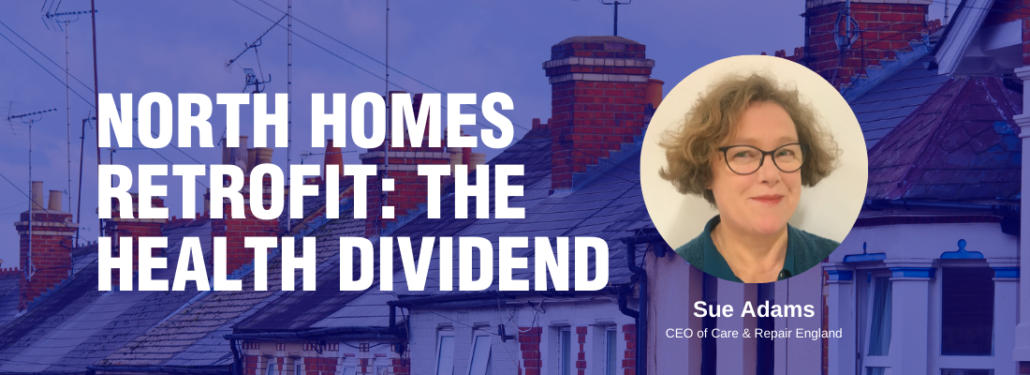North Homes Retrofit: The Health Dividend
Author: Sue Adams, CEO of Care & Repair England
The Covid-19 pandemic has focussed attention on the connections between poor quality housing, people’s health and wellbeing. The pandemic has also ‘exposed and amplified housing-related health inequalities’ [Kings Fund, 2020] and revealed that sectors of the population who are more likely to live in poor housing (older people, those with long-term health conditions, BAME groups, those on low incomes) are often the same groups more vulnerable to Covid-19.
This disproportionate impact of Covid-19 on disadvantaged communities has been starkly evident in the North, as more evidence emerges of the significant geographical differences in death rates and falling life expectancy (Marmot, 2021).
Even before the pandemic, austerity had taken its toll on the health of people living in disadvantaged areas of the North. Whilst life expectancy rose in most places from 2000-2010, from 2010 in some areas it started to decline. By 2014 that life expectancy deterioration had accelerated, and the worst-hit places were urban areas in the North, including Blackpool, Leeds, Liverpool, Manchester and Newcastle (Lancet Public Health Journal, 2021).
The Commission for Housing in the North played a critical role in highlighting the poor condition of many existing homes in the North, noting that national housing policy and resources were focused on new home building, whilst maintaining or improving our current housing stock was, to say the least, a neglected area.
Following on from this observation by the Commission, the NHC tasked the Smith Institute to examine the health impacts and wider costs of poor housing. The hidden costs of poor quality housing in the North identified the scale of costs to the NHS and social care, as well as negative economic, welfare and environmental impacts. It also revealed the high concentration of non-decent homes in the owner occupied sector in the North, with 1 million households affected compared with 354,000 private rented.
The worst affected households were older home owners, and that situation continues to this day. Shockingly, our recent analysis of non-decent homes data reveals a rise of 31% in the number of those over 75yrs living in a non-decent home, with a disproportionate impact on those living in the North. A third of all of the non-decent homes occupied by householders over 75yrs in England (700,705) are in the North (233,425). Given the increasingly serious health impacts of cold, hazardous homes as people age, this has potentially dire consequences for the NHS.
Sadly, despite the Commission’s recommendations and NHC/ Smith Institute evidence, when it came to housing renewal policy, funding or action, little changed over the subsequent five years and to this day there is no dedicated, national capital funding or programme to improve non-decent homes.
However, the challenge of climate change has now highlighted the critical importance of retrofitting the existing housing stock to reduce carbon emissions, with NHC championing the case for investment to improve the thermal standards of homes in the North.
Social landlords can undoubtedly play a key role in this housing transformation, and they could make a huge difference not only for their own tenants but also for those living in other tenures. As early supporters and developers of original Care & Repair and home improvement agencies, they demonstrated vision and wider social purpose. It is no accident that most of the remaining Care & Repair services that are still delivering housing help that goes beyond Disabled Facilities Grants (important as these remain) are in the North of England. They continue to be the leading national pioneers, including targeting housing interventions at the most at risk NHS patients e.g. Manchester Care & Repair contacts and offers housing help to every older patient discharged from hospital.
The Northern Mayors are making the links between action on climate change, improving current homes, health inequalities, employment creation, and economic regeneration. There is a strong case for CO reduction retrofit programmes to incorporate small but critical ‘Healthy Homes’ measures to tackle other non-decent homes hazards (e.g. falls) into programmes of work. For a very small additional cost the health dividend would be significant, and it would leave homes not only warmer but also healthier and safer for generations of occupants.
With the necessary investment, the North could be the first demonstrate far reaching fiscal and social benefits of co-ordinated housing retrofit, including health gains and reductions in health inequalities. Let us hope some of those making decisions at COP26 are listening.



